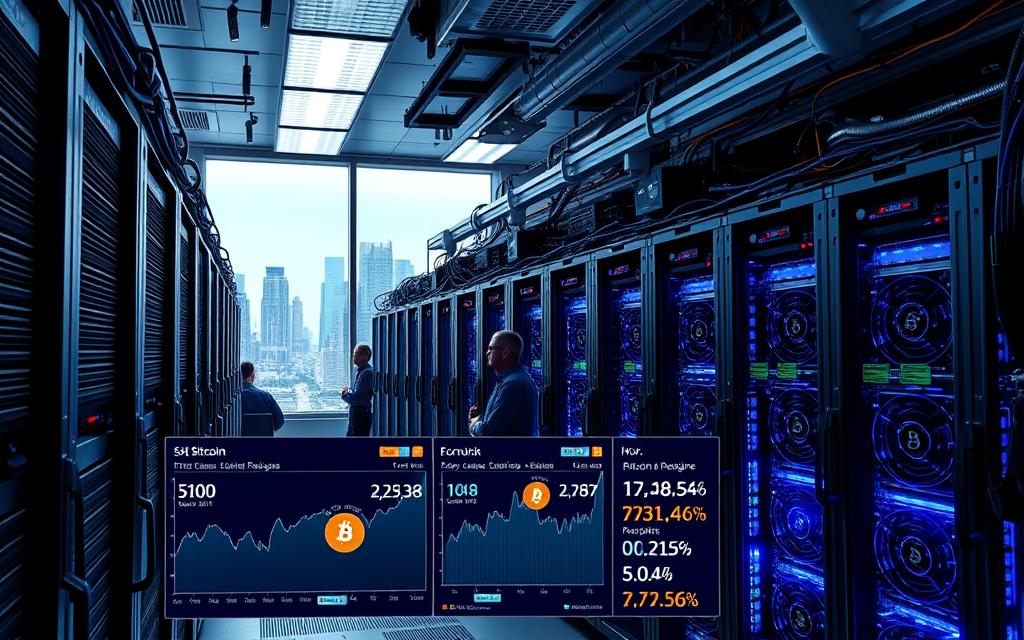Table of Contents
The landscape of Bitcoin mining has dramatically changed since its inception, evolving from a bedroom hobby to a sophisticated industry. In the early days, miners could earn 50 BTC every 10 minutes. Now, after the 2024 halving event, the reward has decreased to 3.125 BTC per block.
The profitability of mining is influenced by several factors, including hardware efficiency, electricity costs, network difficulty, and Bitcoin price volatility. As we examine the current state of mining, the question remains: can miners remain profitable in 2025?
This analysis will delve into the complex interplay of factors determining mining profitability, providing insights for both newcomers and experienced miners to make informed decisions about their operations.
The Current State of Bitcoin Mining in 2025
The Bitcoin mining landscape has undergone significant changes in 2025. The industry has been impacted by the 2024 halving event, advancements in mining technology, and shifts in global mining operations.
Post-2024 Halving Impact
The 2024 halving event marked a pivotal moment for the Bitcoin mining industry, reducing the block reward from 6.25 BTC to 3.125 BTC. This change has fundamentally altered the economics of mining operations worldwide. Despite the reduced block rewards, the Bitcoin network has maintained robust security, with the global hashrate continuing to grow as professional mining operations expand their capacity with more efficient hardware.
- The post-halving landscape has accelerated industry consolidation, with smaller miners facing increased pressure.
- Large-scale operations are leveraging economies of scale to maintain profitability.
Global Mining Landscape
The geographic distribution of mining has continued to evolve, with countries offering renewable energy sources and favorable regulatory environments attracting a greater share of global mining operations. The daily revenue generated by Bitcoin miners remains substantial at approximately $20 million, or around $600 million monthly. However, this revenue is increasingly concentrated among the most efficient and well-capitalized operations.
- Countries with renewable energy sources are becoming hubs for mining operations.
- The industry is seeing a shift towards more efficient and sustainable mining practices.
As the Bitcoin mining industry continues to adapt to the post-halving landscape, it’s clear that efficiency, scale, and strategic location are becoming key factors in determining the profitability of mining operations.
Understanding Bitcoin Mining Fundamentals
To understand the intricacies of bitcoin mining, it’s essential to grasp its fundamental principles. Bitcoin mining is the backbone of all proof-of-work blockchains, serving as the decentralized verification system for the Bitcoin network.
What is Bitcoin Mining?
Bitcoin mining is the process of validating transactions on the Bitcoin network by solving complex mathematical problems. Miners use powerful computers to perform these calculations, and in return, they are rewarded with newly minted bitcoins. The process involves miners competing to solve cryptographic puzzles, with the successful miner receiving the block reward plus transaction fees. For more detailed information on bitcoin mining, you can visit Bankrate’s guide on bitcoin mining.
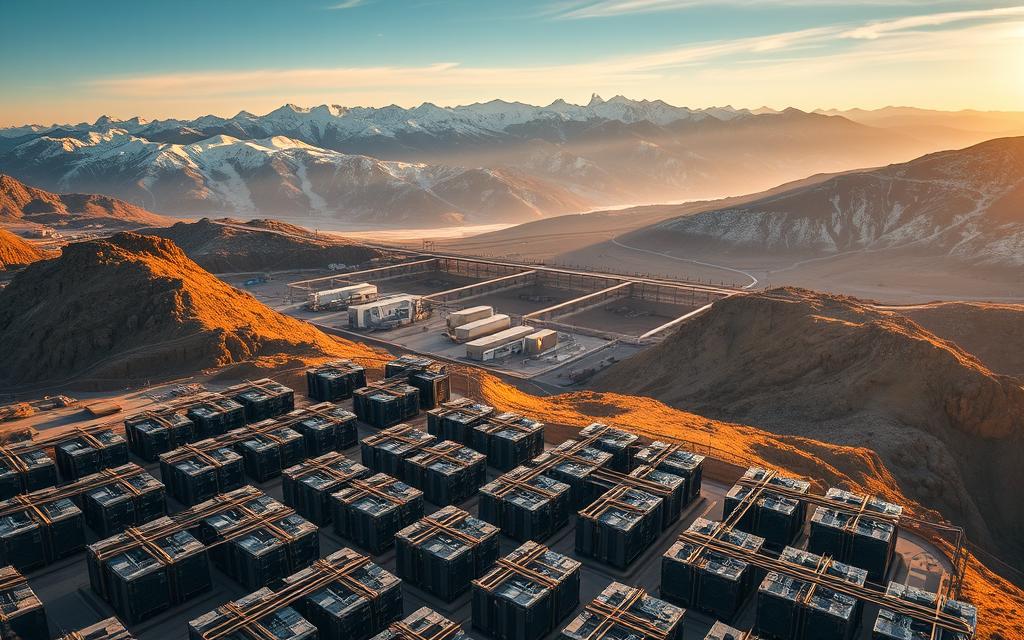
The Role of Miners in the Bitcoin Network
Miners play a crucial role in the Bitcoin network by securing it against attacks and introducing new bitcoins into circulation. The hash rate, or computational power, contributed by miners determines the network’s security. The difficulty adjustment mechanism ensures that blocks are mined at a consistent rate, regardless of the total hash rate. Understanding concepts like hashrate, difficulty, and the block reward is essential for evaluating mining profitability.
The key aspects of mining include:
- Serving as a decentralized verification system for the Bitcoin network
- Securing the network against attacks by making it prohibitively expensive to alter the blockchain
- Introducing new bitcoins into circulation according to a predetermined schedule
- Adjusting difficulty to maintain a consistent block creation rate
Key Factors Determining Mining Profitability
Understanding the key elements that affect mining profitability is crucial for success in the competitive Bitcoin mining landscape. Several critical factors contribute to the overall profitability of mining operations.
Hardware Efficiency and Costs
Hardware efficiency represents the cornerstone of mining profitability. The latest ASIC miners offer significantly better hashrate-to-power consumption ratios than previous generations, directly impacting operational costs and revenue potential. For instance, the Whatsminer M20S is a popular choice among miners due to its high efficiency.
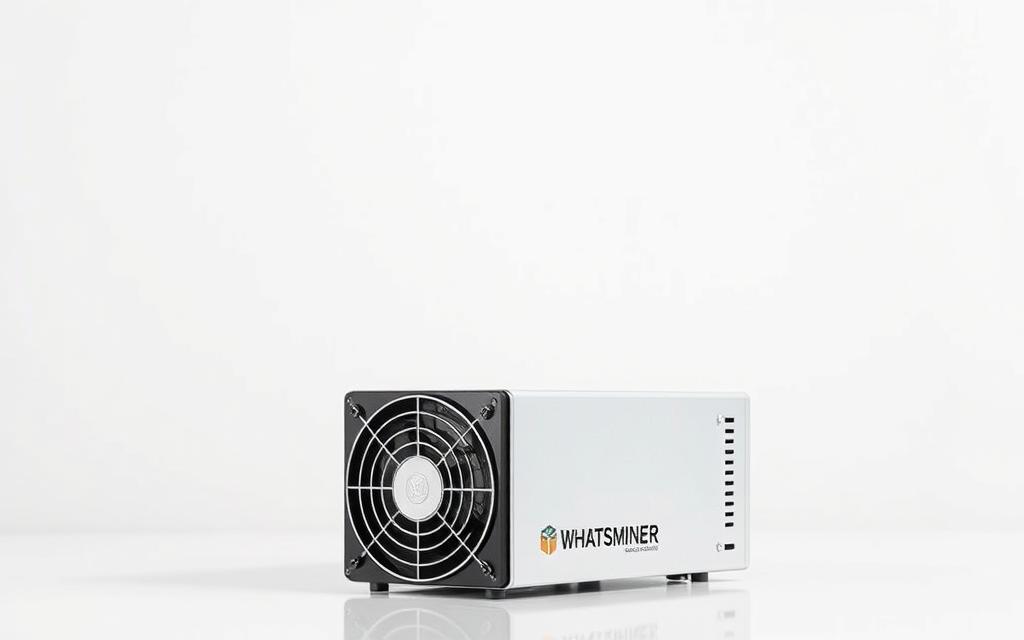
Electricity Expenses
Electricity expenses typically constitute 80-90% of ongoing mining costs. Access to low-cost power, ideally under $0.05/kWh, is essential for maintaining profitable operations in the competitive 2025 mining landscape. Miners often seek locations with low electricity costs to maximize their profitability.
Bitcoin Price and Market Volatility
Bitcoin’s price volatility creates a dynamic profitability environment. Mining operations must be able to weather significant market downturns while capitalizing on price increases that can rapidly transform marginally profitable setups into highly lucrative ones. The market price of Bitcoin directly affects mining revenue.
Network Difficulty and Hashrate
Network difficulty and global hashrate continue to rise as more mining power joins the network, automatically adjusting to maintain the 10-minute block time and directly affecting the share of rewards each miner receives. Miners must continually optimize their operations to remain competitive.
The interplay between these factors creates a complex profitability equation. Miners must continuously optimize their operations to remain competitive, with even small efficiency gains potentially making the difference between profit and loss.
Is Bitcoin Mining Still Profitable in 2025?
As we dive into 2025, the question on every miner’s mind is whether Bitcoin mining remains a profitable venture. The landscape of Bitcoin mining has undergone significant changes, particularly after the 2024 halving event, which reduced block rewards. Despite these changes, Bitcoin mining is still profitable in 2025, but the extent of profitability varies greatly depending on the scale of operations and other factors.
Profitability Analysis for Different Setups
The profitability of Bitcoin mining in 2025 varies dramatically based on operational scale. Industrial mining farms continue to maintain profitability due to their access to cheap electricity, efficient hardware, and economies of scale. In contrast, small-scale miners face significant challenges due to high entry costs and competitive pressures.
Large-scale operations with access to electricity costs below $0.05/kWh, the latest efficient hardware, and economies of scale continue to generate profits despite the reduced block rewards. On the other hand, home miners in regions with standard electricity rates ($0.10-$0.20/kWh) typically operate at a loss unless they have access to subsidized power or can utilize mining heat for other purposes to offset costs.
Break-even Calculations
Break-even calculations have become more complex, with miners needing to factor in not just immediate costs and revenue but also hardware depreciation, potential Bitcoin price appreciation, and increasing network difficulty. The “mine and hold” strategy has gained popularity among miners who can afford to operate at temporary losses, banking on future Bitcoin price increases to eventually make their operations profitable in retrospect.
| Mining Setup | Electricity Cost | Profitability |
|---|---|---|
| Industrial | Below $0.05/kWh | Profitable |
| Small-scale | $0.10-$0.20/kWh | Typically at a loss |
| Home Miner with Subsidized Power | Variable | Potentially profitable |
According to recent data, Bitcoin miners are currently mining around $20 million worth of Bitcoin per day, which translates to $600 million per month. While the average home miner is unlikely to recoup the cost of mining hardware and electricity, the situation may improve in the future once ASIC mining hardware innovation reaches the point of diminishing returns, coupled with cheap and sustainable power solutions.
Mining Hardware Options and ROI
In 2025, the landscape of bitcoin mining is shaped by the efficiency and power of mining hardware. The right equipment can significantly impact the profitability of mining operations.
Latest ASIC Miners and Their Performance
The latest generation of ASIC miners, such as the Antminer S21 and WhatsMiner M60 series, offer significantly improved efficiency metrics (watts per terahash) compared to previous models. These advancements make them essential investments for serious mining operations in 2025.
Hardware costs have decreased relative to performance, with new mining machines priced around $16 per terahash in 2025, compared to $80 per terahash in 2022. However, the initial investment remains substantial, ranging from $2,000 to $20,000 per unit.
GPU Mining Viability for Bitcoin
GPU mining for Bitcoin has become less viable due to the dominance of ASIC miners. However, some miners repurpose GPUs for mining alternative proof-of-work cryptocurrencies that remain ASIC-resistant. For those interested in exploring other mining options, it’s worth considering the viability of GPU mining for other cryptocurrencies.
To learn more about the feasibility of mining cryptocurrencies with a home PC, visit Can You Mine Crypto with a Home PC
Return on investment (ROI) calculations for mining hardware must account for the declining relative value of hashrate over time as network difficulty increases. Most current-generation ASICs require 9-18 months to reach ROI under optimal conditions. Hardware longevity and reliability have become increasingly important factors in profitability calculations, with miners favoring manufacturers with lower failure rates and better warranty services to maximize uptime and operational efficiency.
Mining Approaches: Solo vs. Pool vs. Cloud
Bitcoin mining can be approached in different ways, each with its own advantages and disadvantages. The choice of mining approach significantly impacts a miner’s profitability and risk exposure.
Solo Mining Considerations
Solo mining has become virtually impossible for individual miners due to the massive network hashrate. Even a powerful ASIC miner might wait years before successfully mining a block, making this approach viable only for very large mining operations. For instance, a WhatsMiner M20S ASIC miner with 68 TH/s has approximately a 1 in 1,470,588 chance of mining a Bitcoin block if the Bitcoin Network Hashrate is 100 EH/s.
Pool Mining Benefits and Drawbacks
Pool mining has become the standard approach for most miners, allowing them to receive consistent smaller payments based on their contributed hashrate. However, this comes with pool fees typically ranging from 1-3%. The choice of mining pool significantly impacts profitability, with factors such as fee structure, payout methods (PPS+ vs. PPLNS), server locations, and minimum payout thresholds affecting a miner’s bottom line.

Cloud Mining Services
Cloud mining allows users to rent hashrate from large mining operations without owning or maintaining hardware. While it sounds appealing, cloud mining has a mixed reputation—largely due to scams, hidden fees, and poor ROI. Cloud mining services offer an entry point for those without technical expertise or access to cheap electricity, but they carry significant risks.

Each mining approach presents a different risk-reward profile. Solo mining offers the highest potential reward but greatest variance, pool mining provides consistency but lower returns, and cloud mining offers convenience at the cost of reduced profitability. Miners must carefully evaluate these factors to choose the most suitable approach for their specific circumstances.
Strategies to Maximize Mining Profitability
Maximizing mining profitability in 2025 requires a multifaceted approach, combining technological advancements with operational efficiency. As the Bitcoin mining landscape continues to evolve, miners must adapt to stay competitive.
Optimizing Electricity Costs
One of the most significant factors affecting mining profitability is electricity costs. Miners can substantially reduce their expenses by relocating to regions with access to cheap hydroelectric, solar, or stranded energy sources. For instance, areas like Iceland and Norway offer abundant geothermal and hydroelectric power, respectively, allowing miners to benefit from lower energy costs.
Successful mining operations often prioritize locations with electricity rates below $0.05/kWh. By doing so, they can maintain profitability even when the Bitcoin price fluctuates.
Efficient Cooling Solutions
As mining hardware becomes increasingly dense, efficient cooling solutions have become crucial. Technologies like immersion cooling not only extend hardware lifespan but also enable safe overclocking, increasing hashrate without proportional power increases. This approach helps miners maximize their revenue while minimizing energy consumption.
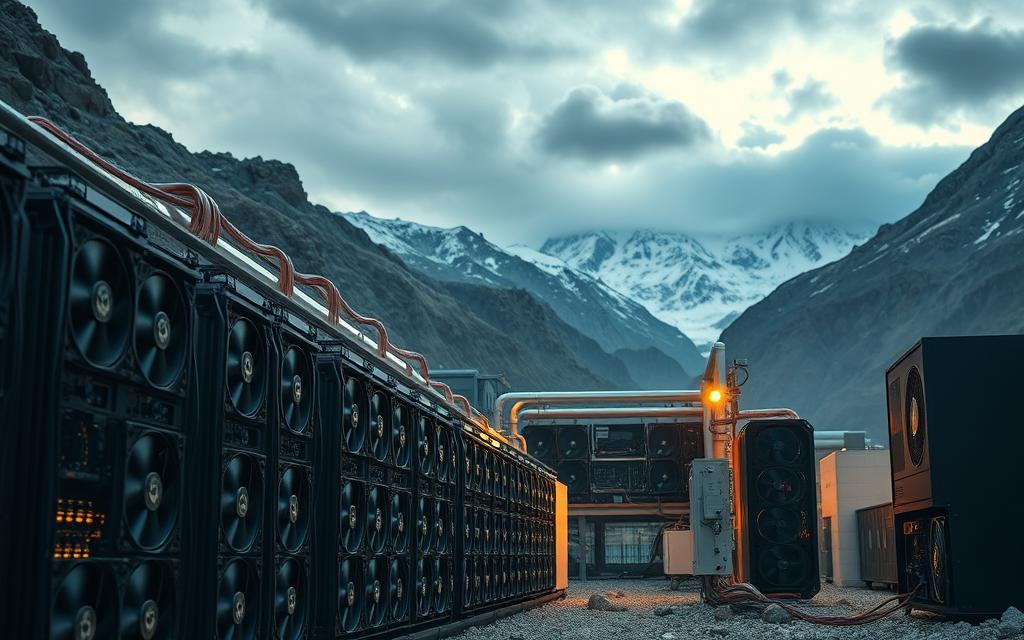
Strategic Coin Selling vs. Holding
Miners must also consider their strategy for selling mined coins versus holding them. Professional mining operations often implement sophisticated treasury management strategies, selling enough Bitcoin to cover operational costs while holding the remainder. This approach allows miners to capitalize on potential future price increases while maintaining liquidity.
| Strategy | Benefits | Impact on Profitability |
|---|---|---|
| Optimizing Electricity Costs | Reduced energy expenses | High |
| Efficient Cooling Solutions | Increased hardware lifespan, improved hashrate | Medium |
| Strategic Coin Selling | Improved liquidity, potential for future gains | High |
By implementing these strategies, miners can significantly enhance their profitability. Regular firmware updates, hardware optimization, and diversification of energy sources and mining locations also contribute to a resilient and profitable mining operation.
Regional Considerations for US-Based Miners
For US-based miners, regional considerations play a crucial role in determining mining profitability. The varied landscape of energy costs, regulatory frameworks, and tax policies across different states significantly impacts the viability of mining operations.
Favorable Mining Conditions by State
Some states have emerged as mining hubs due to their combination of affordable energy and supportive regulatory environments. Texas, Washington, Wyoming, and Kentucky are notable examples, offering competitive electricity rates and favorable policies for miners. States with abundant hydroelectric power or excess natural gas production typically provide the most competitive electricity rates for mining operations, with industrial rates sometimes falling below $0.06/kWh, compared to the national residential average of $0.15/kWh.
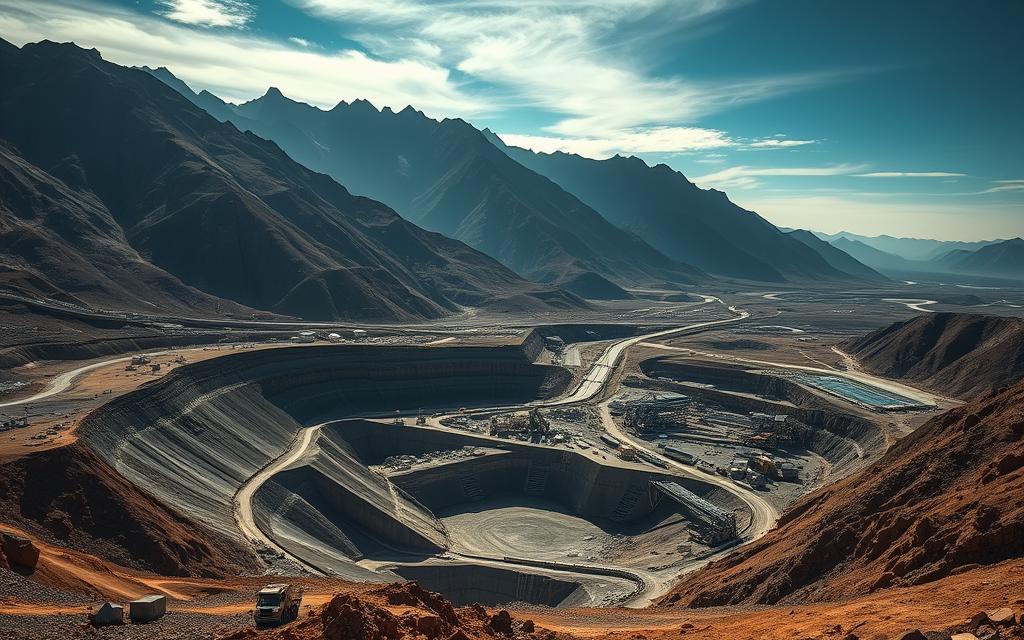
Regulatory Environment and Taxes
The regulatory environment for cryptocurrency mining varies significantly across states, with some actively courting mining operations through tax incentives and favorable policies. Miners must navigate complex rules regarding equipment depreciation, energy credits, and the treatment of mined coins as income versus capital assets. As stated by a prominent industry expert,
“The regulatory landscape for cryptocurrency mining is evolving rapidly, and miners must stay informed to remain competitive.”
Many US mining farms have developed strategic relationships with energy providers, participating in demand response programs that allow them to curtail operations during peak grid demand in exchange for preferential rates during normal operations.
Conclusion: The Future of Bitcoin Mining Profitability
Bitcoin mining’s profitability in the coming years will likely be influenced by technological advancements and energy costs. As ASIC development reaches diminishing returns, coupled with access to cheap and sustainable power solutions, smaller miners may re-enter the market. This shift could increase decentralization, supporting Satoshi Nakamoto’s original vision. For more on ASIC evolution, visit D-Central Tech. The industry’s future looks promising with innovations in energy efficiency and geographic diversification.
FAQ
What are the key factors that determine the profitability of Bitcoin mining?
The key factors that determine the profitability of Bitcoin mining include hardware efficiency and costs, electricity expenses, Bitcoin price and market volatility, and network difficulty and hashrate. These factors can significantly impact the revenue generated by mining operations.
How does the halving event affect Bitcoin mining profitability?
The halving event reduces the block reward, which can lead to decreased revenue for miners unless the price of Bitcoin increases accordingly. Miners must adjust their strategies to maintain profitability in a post-halving environment.
What are the most efficient mining hardware options available?
The most efficient mining hardware options are typically ASIC miners, such as those produced by Bitmain and MicroBT. These devices offer high hash rates while minimizing power consumption.
How can miners optimize their electricity costs?
Miners can optimize their electricity costs by locating their operations in regions with low energy rates, using renewable energy sources, and implementing efficient cooling solutions to reduce power consumption.
What are the benefits and drawbacks of pool mining versus solo mining?
Pool mining allows miners to combine their resources and share rewards, reducing the variance in income. However, it also means sharing the rewards with other pool members. Solo mining offers the potential for full block rewards but comes with a higher risk of not finding a block for an extended period.
How does the regulatory environment impact Bitcoin mining in the US?
The regulatory environment can significantly impact Bitcoin mining in the US, with different states having varying levels of support or restriction for mining operations. Miners must comply with local regulations and tax laws to maintain profitability.
What is the role of cloud mining in the Bitcoin mining industry?
Cloud mining allows users to rent mining hardware and receive a portion of the rewards without directly managing the mining operation. However, it comes with risks such as scams and lack of control over the mining process.
How do miners determine their break-even point?
Miners determine their break-even point by calculating the time it takes for their initial investment to be recovered through mining rewards, taking into account factors such as hardware costs, electricity expenses, and the current Bitcoin price.


